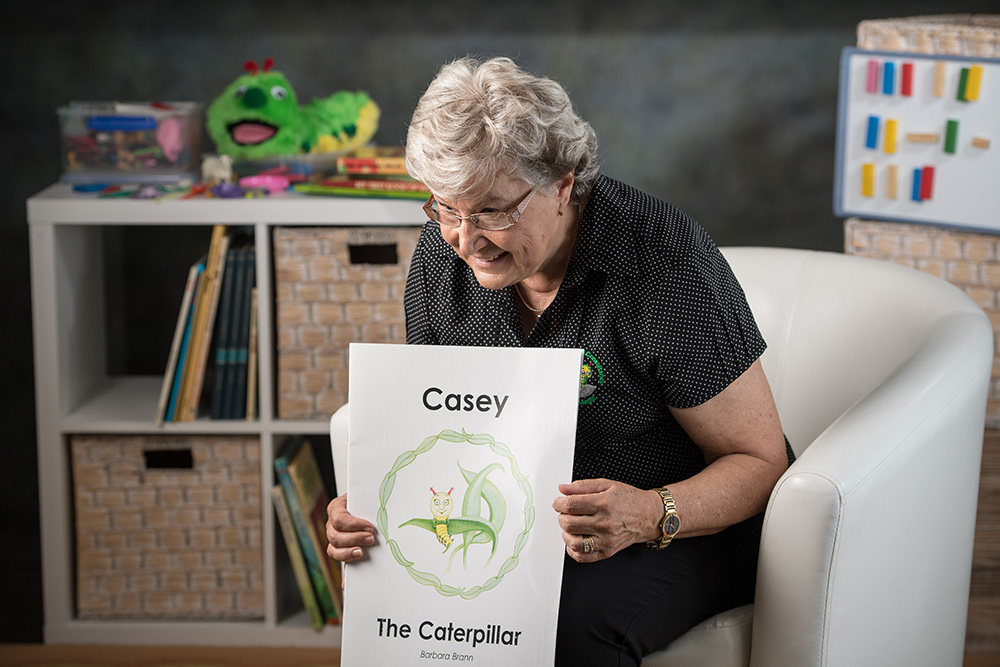Casey the Caterpillar and Barbara Brann
The back story to a magical early literacy learning resource
Early literacy learning will be forever changed through Casey the Caterpillar and Barbara Brann. Their back story is one that reflects Barbara Brann’s own discovery journey through literacy and learning.

Here’s the story of Casey the Caterpillar in Barbara Brann’s own words.
During mid Eighties I was doing a stint in Alice Springs, Australia’s Northern Territory – apparently Caterpillar Dreaming country. While teaching five year olds, I was looking for a way to make learning to write letters easy. Instead of learning 26 completely different “pictures”, I’d been working with the concept of labelling the shapes that comprise letters. Why? Because I knew letters can be formed using a small number of shapes which combine in different ways to form letters.
At the time, I happened to be using caterpillars as the basis for the children’s learning. We had watched our caterpillars in the classroom walk along the branch eating the leaves, spin a cocoon and magically turn into a butterfly (or moth as ours turned out to be!). As a prolific storyteller, and believing children respond to stories better than instruction, it occurred to me that I could use our caterpillars in a story about letter shapes.
I shared with the children that our caterpillar was magic. Building up a whole story around the caterpillar, I illustrated it on the board as I shared the story, finding it expanded with each new step. You can imagine the children. They were enthralled and couldn’t wait to hear the next part.
So the Magic Caterpillar hatched out of an egg the butterfly laid on the branch right next to the tree trunk where it would be safe from the birds, giving it a starting point to start to eat the leaves from left to right – the means to match reading and writing and all letter formation. On the way, the Magic Caterpillar came across leaves, sticks, other insects and animals. Using these, the caterpillar took these shapes to help her to draw letters. Magically, she drew these shapes as she moved across the branch.
The evolution of The Magic Caterpillar Handwriting Process
I used caterpillar story for many years without any resources other than a board, chalk or a marker, and an eraser, allowing the story to change and evolve. I called it The Magic Caterpillar Handwriting – a process to develop correct letter formation. The Magic Caterpillar Handwriting Process was first formally published around 1990. It was so effective that in 1997, my Northern Territory friend, Penny McIntyre wrote it down. She added a few extra touches, suggesting I turn it into a story book with illustrations and publish it. And I did!
The story of Casey the Caterpillar now underpins The Magic Caterpillar Handwriting. It is a process to develop correct letter formation and is used worldwide now. It is not tied to any script because the language of the shapes remains constant, irrespective of what the stick or possum tail looks like in the completed letter.
Although The Magic Caterpillar Handwriting Process developed organically as a way to make learning easier for children, there is considerable research which has now been brought in behind it. The Magic Caterpillar Handwriting Process sits within a broader framework of literacy skills. Working best when taught as part of the entire literacy package, rather than as a separate “subject” at “handwriting time”, the process is also embedded into the continuum of developing gross and fine motor skills necessary for handwriting.
The Magic Caterpillar Handwriting Process is regarded as the “hub” of literacy as it brings together:
- Letter shapes
- Concepts of left to right and back to the margin (the tree trunk) and down to the next line (branch)
- The concept of letter and the concept of word
- Building up of automaticity of high frequency words
- The start of sentence writing.
All elements are taught through the process of learning to write and recognise the shapes that form letters.
Benefits and outcomes from the The Magic Caterpillar Handwriting Process
Apart from the joy of seeing a child develop, there are many beneficial outcomes from The Magic Caterpillar Handwriting:
- Handwriting becomes the engine pulling all other aspects of literacy along simultaneously
- Reading is easier because the underpinning skills are in place
- Written language does not struggle through months of marks on paper
- Correct letter formation and letter recognition are in place
- High frequency words are taught as part of the handwriting process ready to be used in reading and writing
- If phonemic awareness skills are incorporated as well, sound-to-letter information falls into place without the need of specific teaching of a letter a week
- Children write legible, phonetically readable words and sentences within months after entering school
